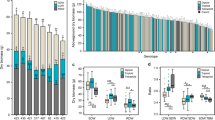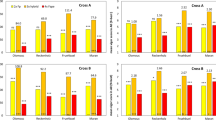Abstract
Polyploidy is a common observation in the genus Salix, including some of the shrub willow species currently being bred as a potential bioenergy feedstock. Breeding of shrub willow has produced new species hybrids, among which a disproportionate number of high-yielding genotypes are triploid, produced from crosses between diploid and tetraploid parents. These novel hybrids display significant variation in biomass compositional quality, including differences according to ploidy. The triploid and tetraploid genotypes possess lower lignin content than diploid genotypes. Biomass composition was also significantly different across the 3-year growth cycle typical of bioenergy plantings. There were differences in syringyl/guaiacyl (S:G) lignin ratios among the 75 genotypes examined, in addition to significant correlations with willow growth traits, yield, and composition. These differences suggest that a long-term strategy of breeding for triploid progeny will generate cultivars with improved growth traits and wood composition for conversion to biofuels.






Similar content being viewed by others
References
Argus GW (1997) Infrageneric classification of Salix (Salicaceae) in the New World. The American Society of Plant Taxonomists. Mich, Ann Arbor
Larsson S (1998) Genetic improvement of willow for short-rotation coppice. Biomass Bioenerg 15:23–26
Smart LB, Cameron KD (2008) Genetic improvement of willow (Salix spp.) as a dedicated energy crop. In: Vermerris WE (ed) Genetic improvement of Bioenergy crops. Springer Science, New York, pp 347–376
Karp A, Hanley S, Trybush S, Macalpine W, Pei MH, Shield I (2011) Genetic improvement of willow for bioenergy and biofuels. J Integr Plant Biol 53:151–165
Volk TA, Abrahamson LP, Cameron KD, Castellano P, Corbin T, Fabio E, Johnson G, Kuzovkina-Eischen J, Labrecque M, Miller R, Sidders D, Smart LB, Staver K, Stanosz GR, Van Rees K (2011) Yields of willow biomass crops across a range of sites in North America. Aspects Appl Biol 112:67–74
Serapiglia MJ, Cameron KD, Stipanovic AJ, Abrahamson LP, Volk TA, Smart LB (2012) Yield and woody biomass traits of novel shrub willow hybrids at two contrasting sites. BioEnerg Res 6:533–546
Lin J, Gibbs JP, Smart LB (2009) Population genetic structure of native versus naturalized sympatric shrub willows (Salix; Salicaceae). Am J Bot 96:771–785
Weih M, Rönnberg-Wästljung A-C, Glynn C (2006) Genetic basis of phenotypic correlations among growth traits in hybrid willow (Salix dasyclados x S. viminalis) grown under two water regimes. New Phytol 170:467–477
Cameron KD, Phillips IS, Kopp RF, Volk TA, Maynard CA, Abrahamson LP, Smart LB (2008) Quantitative genetics of traits indicative of biomass production and heterosis in 34 full-sib F1 Salix eriocephala families. BioEnerg Res 1:80–90
Orians CM, Huang C, Wild A, Zee P, Dao MTT, Fritz RS (1997) Willow hybridization differentially affects preference and performance of herbivorous beetles. Entomol Exp Appl 83:285–294
Pei MH, Lindegaard K, Ruiz C, Bayon C (2008) Rust resistance of some varieties and recently bred genotypes of biomass willows. Biomass Bioenerg 32:453–459
Pei MH, Shield I, Macalpine W, Lindegaard KN, Bayon C, Karp A (2010) Mendelian inheritance of rust resistance to Melampsora larici-epitea in crosses between Salix sachalinensis and S. viminalis. Plant Pathol 59:862–872
Zsuffa L, Mosseler A, Raj Y (1984) Prospects for interspecific hybridization in willow for biomass production. In: Perttu K (ed) Ecology and management of forest biomass production systems, vol 15. Swed. Univ. Agric. Sci, Uppsala, pp 261–281
Riedelsheimer C, Czedik-Eysenberg A, Grieder C, Lisec J, Technow F, Sulpice R, Altmann T, Stitt M, Willmitzer L, Melchinger AE (2012) Genomic and metabolic prediction of complex heterotic traits in hybid maize. Nature Genet 44:217–220
Chen ZJ (2013) Genomic and epigenetic insights into the molecular bases of heterosis. Nat Rev Genet 14:471–482
Goff SA, Zhang Q (2013) Hetosis in elite hybrid rice: speculation on the genetic and biochemical mechanism. Curr Opin Plant Biol 16:221–227
Serapiglia MJ, Gouker FG, Smart LB (2014) Early selection of novel triploid hybrids of shrub willow with improved biomass yield relative to diploids. BMC Plant Biol 14:74. doi:10.1186/1471-2229-1114-1174
Nilsson-Ehle H (1938) Uber eine in der naturgefundene gigasform von Populus tremula. Hereditas 21:379–383
Zhang P, Wu F, Kang X (2012) Genotypic variation in wood properties and growth traits of triploid hybrid clones of Populus tomentosa at three clonal trials. Tree Genet Genomes 8:1041–1050
Denis M, Favreau B, Ueno S, Camus-Kulandaivelu L, Chaix G, Gion JM, Nourrisier-Mountou S, Polidori J, Bouvet JM (2013) Genetic variation of wood chemical traits and association with underlying genes in Eucalyptus urophylla. Tree Genet Genomes 9:927–942
Porth I, Klápště J, Skyba O, Friedmann MC, Hannemann J, Ehlting J, El-Kassaby YA, Mansfield SD, Douglas CJ (2013) Network analysis reveals the relationship among wood properties, gene expression levels and genotypes of natural Populus trichocarpa accessions. New Phytol 200:727–742
Zhang P, Wu F, Kang X (2013) Genetic control of fiber properties and growth in triploid hybrid clones of Populus tomentosa. Scand J Forest Res 28:621–630
Serapiglia MJ, Cameron KD, Stipanovic AJ, Smart LB (2009) Analysis of biomass composition using high-resolution thermogravimetric analysis and percent bark content as tools for the selection of shrub willow bioenergy crop varieties. BioEnerg Res 2:1–9
TAPPI Standard T 258 om-06 (2006) Basic density and moisture content of pulpwood. In TAPPI Test Methods 2006. TAPPI Press, Technology Park, Atlanta
Huntley SK, Ellis D, Gilbert M, Chapple C, Mansfield S (2003) Significant increases in pulping efficiency in C4H-F5H transformed poplars: improved chemical savings and reduced environmental toxins. J Agr Food Chem 51:6178–6183
Robinson AR, Mansfield SD (2009) Rapid analysis of poplar lignin monomer composition by a streamlined thioacidolysis procedure and near-infrared reflectance-based prediction modeling. Plant J 58:706–714
SAS Institute Inc. SAS 9.1.3 Help and documentation. In. Cary, NC: SAS Institute Inc., 2000–2004
Armstrong J (1982) Polyploidy and wood anatomy of mature white ash, Fraxinus americana. Wood Fiber Sci 14:331–339
Van Buijtenen JP, Joranson PN, Einspahr DW (1958) Diploid versus triploid aspen as pulpwood sources, with reference to growth, chemical, physical, and pulping differences. TAPPI 41:170–175
Einspahr DW, van Buijtenen JP, Peckman JR (1963) Natural variation and heritability in triploid aspen. Silvae Genet 12
Benson MK, Einspahr DW (1967) Early growth of diploid, triploid and triploid hybrid aspen. Forest Sci 13:150–155
Hu B, Wang B, Wang C, Song W, Chen C (2012) Microarray analysis of gene expression in triploid black poplar. Silvae Genet 61:148–157
Birchler JA, Veitia RA (2012) Gene balance hypothesis: connecting issues of dosage sensitivity across biological disciplines. Proc Natl Acad Sci U S A 109:14746–14753
Yao H, Gray AD, Auger DL, Birchler JA (2013) Genomic dosage effects on heterosis in triploid maize. Proc Natl Acad Sci U S A 110:2665–2669
Novaes E, Kirst M, Winter-Sederoff H, Sederoff R (2010) Lignin and biomass: a negative correlation for wood formation and lignin content in trees. Plant Physiol 154:555–561
Kirst M, Myburg AA, De Leon JPG, Kirst ME, Scott J, Sederoff R (2004) Coordinated genetic regulation of growth and lignin revealed by quantitative trait locus analysis of cDNA microarray data in an interspecific backcross of Eucalyptus. Plant Physiol 135:2368–2378
Shafizadeh F, Chin PPS (1977) Thermal deterioration of wood. In IS Goldstein, ed, Wood Technology: Chemical Aspects. American Chemical Society Symposium Series 43, pp 57–81
Demirbaş A (2001) Relationships between lignin contents and heating values of biomass. Energy Convers Manag 42:183–188
Serapiglia MJ, Humiston MC, Xu H, Hogsett DA, de Orduna RM, Stipanovic AJ, Smart LB (2013) Enzymatic saccharification of shrub willow genotypes with differing biomass composition for biofuel production. Front Plant Sci 4:57. doi:10.3389/fpls.2013.00057
Van Acker R, Leplé J-C, Aerts D, Storme V, Goeminne G, Ivens B, Légée F, Lapierre C, Piens K, Van Montagu MCE, Santoro N, Foster CE, Ralph J, Soetaert W, Pilate G, Boerjan W (2014) Improved saccharification and ethanol yield from field-grown transgenic poplar deficient in cinnamoyl-CoA reductase. Proc Natl Acad Sci U S A 111:845–850
Brereton NJB, Ray MJ, Shield I, Martin P, Karp A, Murphy RJ (2012) Reaction wood—a key cause of variation in cell wall recalcitrance in willow. Biotech Biofuel 5:83. doi:10.1186/1754-6834-1185-1183
Studer MH, DeMartini JD, Davis MF, Sykes RW, Davison B, Keller M, Tuskan GA, Wyman CE (2011) Lignin content in natural Populus variants affects sugar release. Proc Natl Acad Sci U S A 108:6300–6305
Mansfield SD, Kang K-Y, Chapple C (2012) Designed for deconstruction—poplar trees altered in cell wall lignification improve the efficacy of bioethanol production. New Phytol 194:91–101
Acknowledgments
This work was funded by grants from the Northeast Sun Grant Initiative from the US Department of Transportation and the US Department of Agriculture. The authors would like to thank Kayla Relyea, Michelle Von Loessl, Berdine Coetzee, and Rebecca Chase for their assistance on this project. Steve Gordner and Matt Christiansen provided expert assistance with field trial establishment, maintenance, and harvesting. Additional technical support was provided by Kimberly Cameron, Michael Rosato, Kayleigh Hogan, Jane Petzoldt, Cody Lafler, and James Ballerstein.
Author information
Authors and Affiliations
Corresponding author
Electronic Supplementary Material
Below is the link to the electronic supplementary material.
Online Resource 1
(PDF 26 kb)
Online Resource 2
(XLSX 41 kb)
Online Resource 3
(PDF 8 kb)
Rights and permissions
About this article
Cite this article
Serapiglia, M.J., Gouker, F.E., Hart, J.F. et al. Ploidy Level Affects Important Biomass Traits of Novel Shrub Willow (Salix) Hybrids. Bioenerg. Res. 8, 259–269 (2015). https://doi.org/10.1007/s12155-014-9521-x
Published:
Issue Date:
DOI: https://doi.org/10.1007/s12155-014-9521-x




